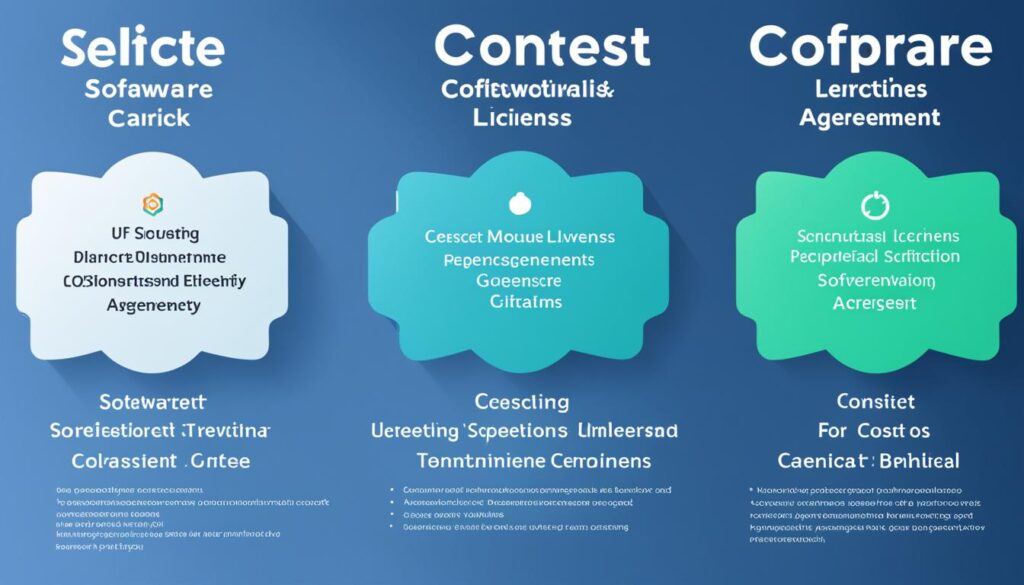Existing customer? Sign in
Software Licensing Explained – Your Guide

Did you know that software piracy costs businesses an estimated $359 billion globally each year? It’s a staggering figure that highlights the importance of software licensing in protecting intellectual property and ensuring compliance with legal guidelines.
Software licenses are crucial documents that establish the rights and responsibilities of both developers and users. Whether you’re a software developer looking to protect your work or an end user seeking to navigate licensing terms, understanding software licensing is essential.
Key Takeaways:
- Software licenses outline the guidelines for the use and distribution of software, protecting both developers and users.
- There are different types of software licenses, including proprietary, free, and open source licenses, each with its own terms and conditions.
- Software licenses play a crucial role in protecting intellectual property, allowing legal software use and modification, and preventing unauthorized distribution.
- Software license costs can vary depending on factors like license type, software type, pricing model, and user count.
- Understanding software license agreements is essential for avoiding legal issues, maintaining positive relationships with developers, and maximizing software usage.
Understanding How Software Licenses Work
Software licenses are an essential aspect of the software industry, governing the terms of use for both users and developers. By understanding how software licenses work, users can ensure compliance while developers can protect their intellectual property.
When acquiring software, users enter into a contract known as a software license agreement. This agreement outlines the terms and conditions regarding the use and distribution of the software. Users must agree to these terms before obtaining access to the software.
“A software license is a contract between the user or user organization and the developer, outlining the terms of use for the software.”
Software licenses often come with a unique license key or product key. This key is used to verify and activate the software on a specific computer or device. It also identifies the specific version of the software being used.
“Software licenses often come with a license key or product key, which is used to verify and activate the software on a specific computer or device.”
License agreements include various details to clarify the rights and responsibilities of both users and developers. These details typically cover charges, duration of the license, distribution permissions, and user rights for copying and modifying the software. Furthermore, license agreements may also include guarantees, maintenance, and support terms.
“License agreements include various details, such as charges, duration, distribution permissions, and user rights for copying and modifying the software.”
Software licenses play a crucial role in safeguarding developers’ intellectual property rights. They allow users to legally use and modify software code they did not write, fostering innovation and collaboration. Additionally, software licenses facilitate positive relationships between developers, vendors, and end-users, ensuring that all parties benefit from the software’s usage.
“Software licenses play a crucial role in protecting developers’ intellectual property and allowing users to legally use and modify software code they did not write.”
| Benefits of Software Licenses | Role in Protecting Intellectual Property | Building Positive Relationships |
|---|---|---|
| – Establishes terms of use | – Safeguards developer rights | – Facilitates collaboration and innovation |
| – Clarity on charges and duration | – Allows legal use of code | – Ensures users comply with licensing terms |
| – Grants distribution permissions | – Supports end-user needs | – Prevents overspending on licenses |
| – User rights for copying and modifying | – Enhances developers’ reputation | – Promotes trust and loyalty |
Exploring Different Types of Software Licenses
Software licenses play a vital role in the world of technology by defining the terms and conditions for the use, distribution, and modification of software. When it comes to software licenses, there are primarily two broad categories: Free and Open Source Software (FOSS) licenses and Proprietary licenses.
FOSS licenses, as the name suggests, provide users with the freedom to access, modify, and distribute the source code of the software. This allows developers and users to collaborate, customize, and contribute to the software’s development. Popular FOSS licenses include the GNU General Public License (GPL), MIT License, and Apache License. These licenses empower the software community, fostering innovation, community-driven improvements, and knowledge sharing.
On the other hand, proprietary licenses, also known as closed-source licenses, impose restrictions on users regarding the modification and distribution of the software. Proprietary software is owned by an individual or an organization who retains exclusive rights over its source code. This type of license often requires users to purchase a license to use the software and do not grant access to its source code. Examples of proprietary licenses include Microsoft End-User License Agreement (EULA) and Adobe Photoshop License Agreement.
To gain a more comprehensive understanding of software licenses, it is essential to explore the various types of licenses within each category. These include:
- Public Domain License: This type of license places the software in the public domain, allowing users complete freedom to use, modify, and distribute the software without any restrictions. It enables users to build upon the work of others without the need for explicit permission.
- Lesser General Public License (LGPL): The LGPL is a FOSS license that allows the linking of software components with non-free software. It provides more flexibility by permitting downstream users to modify the licensed software while preserving the original licensing terms.
- Permissive License: Permissive licenses, such as the BSD License, grant users the freedom to modify, distribute, and use the software without imposing significant restrictions. They tend to be more lenient in terms of attribution, licensing compatibility, and redistribution requirements.
- Copyleft License: Copyleft licenses, like the GPL, ensure that derivative works or modifications of the software are also distributed under the same copyleft license. They aim to preserve the freedom of the software and ensure that any improvements made to the program are shared with the community.
- Proprietary License: Proprietary licenses restrict users from modifying, distributing, or accessing the source code of the software. These licenses offer exclusive rights to the software’s owners and often require users to purchase a license for legal use.
Understanding Software License Costs and Agreements
When it comes to software licenses, costs can vary significantly based on a range of factors. These factors include the type of license, the type of software, the pricing model, and the number of users or devices. Software license costs can range from being completely free to reaching thousands of dollars.
One important factor in determining software license costs is the type of license itself. Some software licenses are perpetual, which means that the user purchases the license upfront and owns the software indefinitely. On the other hand, there are subscription-based licenses, where the user pays a recurring fee for ongoing access to the software. The choice between perpetual and subscription-based licenses depends on the user’s needs and budget.
To understand the costs and obligations associated with a software license, it is crucial to review the software license agreement. This agreement provides essential information about parties involved, charges, cancellation terms, distribution permissions, software performance guarantees, and maintenance and support details. Additionally, the agreement specifies the number of eligible users and the transferability of the license.
Understanding software license costs and agreements is vital for both software developers and users. Developers need to determine fair pricing for their software while considering factors such as development costs and market demand. Users, on the other hand, need to evaluate the affordability and value of a software license in relation to their specific needs and budget.
“The software license agreement serves as the foundation for a transparent and mutually beneficial relationship between the software developer and the user. It outlines the rights and responsibilities of both parties, ensuring clarity and protection for all involved.”
By carefully considering software license costs and agreements, users can make informed decisions and maintain compliance with licensing terms. Developers can also establish fair pricing models and protect their intellectual property rights. In summary, understanding software license costs and agreements is essential for both parties to build a successful and mutually beneficial relationship.
Table: Comparison of Perpetual and Subscription-based Software Licenses
| Perpetual License | Subscription-based License |
|---|---|
| One-time upfront payment | Recurring fee |
| Ownership of software | Rights to use the software as long as the subscription is active |
| Potential for long-term cost savings | Flexibility to scale or cancel the subscription as needed |
| May require additional costs for maintenance and support | Often includes maintenance and support in the subscription fee |
Conclusion
Software licenses play a vital role in the world of technology, ensuring proper distribution, use, and protection of software. They serve as legal agreements between developers, providers, and end users, outlining the rights and responsibilities of each party. Understanding the different types of software licenses and their implications is crucial for both developers and users.
By establishing guidelines for software distribution and modification, software licenses protect developers’ intellectual property and help maintain a fair and competitive marketplace. They provide users with the necessary permissions to use the software while respecting copyright laws and licensing terms. Choosing the right software license is essential for both individuals and organizations to ensure compliance and avoid legal issues.
Whether it’s a proprietary license that grants exclusive rights to the software owner or a free and open source software license that promotes collaboration and customization, each license type has its own benefits and considerations. Developers and users should carefully evaluate their specific needs and goals to determine the most suitable license for their software projects.
In conclusion, software licensing is a complex yet essential aspect of the technology industry. It enables innovation, protects intellectual property, and ensures fair use and distribution of software. By understanding the various types of software licenses and their implications, individuals and organizations can navigate the software landscape with confidence and make informed decisions about licensing their software.
FAQ
What is a software license?
A software license is a legally binding document that outlines the guidelines for the use and distribution of software. It provides end users with the right to use the software while respecting copyright laws and intellectual property rights.
What are the different types of software licenses?
There are different types of software licenses, including public domain, lesser general public license, permissive, copyleft, and proprietary. These licenses vary in their restrictions on software redistribution and modification.
Why are software licenses important?
Software licenses are important as they establish the rights of all parties involved, including the author, the provider, and the end users. They protect developers from unauthorized use of their software and help users stay in compliance with licensing terms.
What is a software license key?
A software license key, also known as a product key, is used to verify and activate the software on a specific computer or device. The key also identifies the specific version of the software.
What information is included in a software license agreement?
License agreements include various details, such as charges, duration, distribution permissions, and user rights for copying and modifying the software. They may also include guarantees, maintenance, and support terms.
What are the types of software licenses?
The two general types of software licenses are free and open source software (FOSS) licenses and proprietary licenses. FOSS licenses provide users with access to source code, allowing them to modify and distribute the software. Proprietary licenses restrict users from altering or distributing the software.
How much do software licenses cost?
Software license costs depend on various factors, such as the type of license, type of software, pricing model, and number of users or devices. Costs can range from free to thousands of dollars.
What are the different types of software license agreements?
Software license agreements can be perpetual, where the user buys the license upfront and owns the software indefinitely, or subscription-based, where the user pays a recurring fee for access.
What information is included in a software license agreement?
A software license agreement includes basic information about the parties involved, charges, cancellation terms, distribution permissions, software performance guarantees, and maintenance and support details. It also specifies the number of eligible users and transferability of the license.
Why are software licenses important for developers and users?
Software licenses play a crucial role in protecting developers’ intellectual property and allowing users to legally use and modify software code they did not write. They also help users maintain positive relationships with developers and vendors and prevent overspending on licenses.
Source Links
- https://www.techtarget.com/searchcio/definition/software-license
- https://www.revenera.com/blog/software-monetization/software-licensing-models-types/
- https://cpl.thalesgroup.com/software-monetization/software-licensing-models-guide




